| EditRegion3 |
Gillette! - Arizona
Ghost Towns
by mark quigley, feature
for The Arizona Sportsman's Journl TV (www.azho.com)
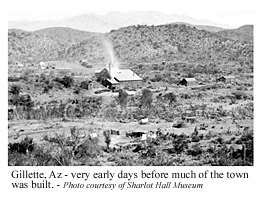 I
love to hunt for old ghost towns, mines and mining camps.
I have done this in and around the Lake Pleasant area
since I was a kid. My dad is quite the ghost town hunter
and would drag our family around to many interesting places.
As a pilot, he would fly the area he wanted to explore
than we would be off in his old jeep looking for these
haunts. Later, when I got a drivers license I was off
on my own doing the same thing. I think I have found every
ghost town and mining camp in the southern Bradshaw Mountains.
I have also spent countless hours at museums and libraries
searching old records for the history of these now lonely
places. I
love to hunt for old ghost towns, mines and mining camps.
I have done this in and around the Lake Pleasant area
since I was a kid. My dad is quite the ghost town hunter
and would drag our family around to many interesting places.
As a pilot, he would fly the area he wanted to explore
than we would be off in his old jeep looking for these
haunts. Later, when I got a drivers license I was off
on my own doing the same thing. I think I have found every
ghost town and mining camp in the southern Bradshaw Mountains.
I have also spent countless hours at museums and libraries
searching old records for the history of these now lonely
places.
For
many years I worked at Lake Pleasant as an officer and
searcher out many of its historical places. I love to
photograph old places and I thought I would start a form
on exploring the western history around the Lake Pleasant
area. I have a large gallery and my photographic prints
are on display at the Lake Pleasant Desert Outdoor Center.
If you ever want to look at some of these old places,
this might help in deciding where to visit first.
Of
course this is the wrong time of year to be out looking
at old mines and haunted towns but cool weather is not
far off. Well here is a my first attempt to get you interested
in the great Arizona outdoors and its unique western history.
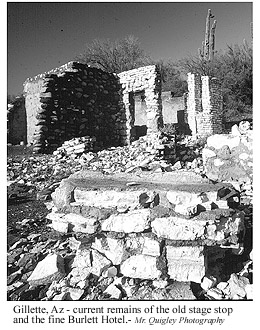 Just
over a mile from Lake Pleasant Park lies the ghost town
of Gillette. This is one ghost town that has always amazed
me. It always pops up in old newspaper accounts and seems
to have been a busy and lively town. Wyatt Earp and many
other well known Arizonans passed this way. What I find
amazing is how a town so well known to Arizona history
can die with so little remaining. Just
over a mile from Lake Pleasant Park lies the ghost town
of Gillette. This is one ghost town that has always amazed
me. It always pops up in old newspaper accounts and seems
to have been a busy and lively town. Wyatt Earp and many
other well known Arizonans passed this way. What I find
amazing is how a town so well known to Arizona history
can die with so little remaining.
Gillette
earned a reputation as a lawless Western town. By March
1878, three men had already been killed in saloon gunfights.
Through the years, the ladies of Gillette tried to turn
it into a civilized town by holding town socials and inviting
traveling preachers, but without much success. Gillette
served as a well-used stage stop. It also had a large
and busy gold/silver mill that ran a profitable operation.
The area’s miners, cowboys and stage drivers spent
a lot of time in the town’s several saloons.
Several
times the towns blacksmith managed to hold up the Wells
Fargo stagecoach in Squaw Creek Canyon a few miles north
of Gillette. By the time the stage arrived in town, the
blacksmith would be back in his shop busily occupied with
his blacksmithing trade. The blacksmith was eventually
caught.
On
June 12, 1878, two killings and a lynching took place
in Gillette within a few hours. A man named Setwright
became involved in an argument in one of Gillette’s
saloons and broke a bottle over the head of another man.
Deputy Sheriff C. Burnett stepped inside the saloon and
arrested Setwright for his drunken behavior. Later that
day, Mr. Weir, a respected town citizen, asked the deputy
to release Setwright into his custody. The deputy agreed,
and the two rode out of town together. A short time later,
the mule Mr. Weir had been riding wandered back into Gillette.
An immediate investigation produced Weir’s body,
shot through the head, a short distance out of town. Deputy
Burnett and several other men saddled their horses and
took off in search of Setwright. He was captured about
a mile and a half from Gillette and taken back to town.
Gillette had no jail, so Setwright was placed inside the
house of Col. Taylor and E. P. Rains until he could be
taken to Prescott for trial.

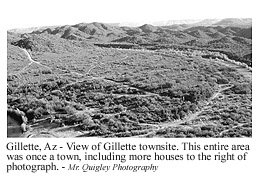 By
now, word had spread of the recent murder and an angry
mob of citizens began gathering outside the home where
Setwright was being held. As time passed, the crowd
became more and more angry and bent on dealing out their
own punishment. Sheriff Burnett tried to calm the mob
by telling them that Setwright would be taken to Prescott
where law and justice would decide his fate. His protests
failed and demands and threats from the excited crowd
increased. They threatened to burn down or blow up the
house unless Setwright was delivered to them. Col. Taylor,
the homeowner, stepped outside with his double-barreled
shotgun in an attempt stop the crowd. Someone in the
crowd aimed a gun, a shot rang out and Col. Taylor slumped
to the ground, dead. Realizing that it was impossible
to defend his prisoner from the bloodthirsty mob, Deputy
Burnett and Raines released him. The now terrified and
sober Setwright was dragged from the house, and minutes
later his body was swinging from the branch of a cottonwood
tree on the banks of the Agua Fria River. By
now, word had spread of the recent murder and an angry
mob of citizens began gathering outside the home where
Setwright was being held. As time passed, the crowd
became more and more angry and bent on dealing out their
own punishment. Sheriff Burnett tried to calm the mob
by telling them that Setwright would be taken to Prescott
where law and justice would decide his fate. His protests
failed and demands and threats from the excited crowd
increased. They threatened to burn down or blow up the
house unless Setwright was delivered to them. Col. Taylor,
the homeowner, stepped outside with his double-barreled
shotgun in an attempt stop the crowd. Someone in the
crowd aimed a gun, a shot rang out and Col. Taylor slumped
to the ground, dead. Realizing that it was impossible
to defend his prisoner from the bloodthirsty mob, Deputy
Burnett and Raines released him. The now terrified and
sober Setwright was dragged from the house, and minutes
later his body was swinging from the branch of a cottonwood
tree on the banks of the Agua Fria River.
Gillette’s
lawless reputation grew through the years. The town
was also known as the stage robber’s capital of
Arizona. More than nine stagecoach robberies occurred
a few miles north of Gillette.
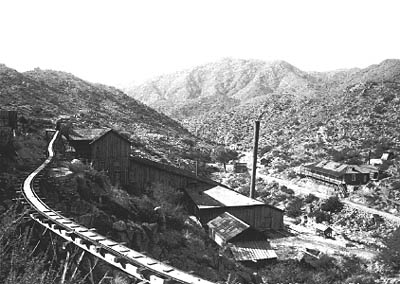 The
Gillette silver mill served the town of Tip Top. Silver
from the Tip Top mines was hauled nine miles over steep
mountain roads to the mill. Once melted, it was shipped
to San Francisco, again by wagon. Gillette was named after
Dan B. Gillette, the Tip Top mine’s superintendent.
The town’s lots sold for $100 each, with corner
lots costing $350. Six streets, Main, California, North,
Pine, Mill and Market, and five blocks comprised the town.
There were shady streets with modest houses, several stores,
a blacksmith, other businesses, four saloons, a post office
and the fine Burfind Hotel. The town lacked a badly needed
jail and church. Jack Swilling, the leader of the party
that first settled the Phoenix area, lived here. One business
was opened by Charles T. Hayden, father of Arizona’s
Senator Carl Hayden. The
Gillette silver mill served the town of Tip Top. Silver
from the Tip Top mines was hauled nine miles over steep
mountain roads to the mill. Once melted, it was shipped
to San Francisco, again by wagon. Gillette was named after
Dan B. Gillette, the Tip Top mine’s superintendent.
The town’s lots sold for $100 each, with corner
lots costing $350. Six streets, Main, California, North,
Pine, Mill and Market, and five blocks comprised the town.
There were shady streets with modest houses, several stores,
a blacksmith, other businesses, four saloons, a post office
and the fine Burfind Hotel. The town lacked a badly needed
jail and church. Jack Swilling, the leader of the party
that first settled the Phoenix area, lived here. One business
was opened by Charles T. Hayden, father of Arizona’s
Senator Carl Hayden.
James
Barney, a Phoenix historian, was quoted in a newspaper,
“I strayed down to Gillette the other day and found
the Tip Top Mill running all right, the place was full
of people, and teams and pack trains running in and out.
The place is well represented in all kinds of businesses
necessary to supply the wants of the public except in
the matter of saloons, there being only four in full blast.
. . .”
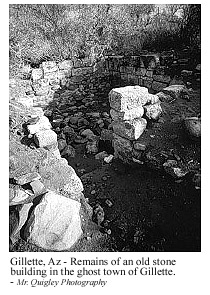 Gillette
quickly declined after the Tip Top Mining Company moved
its mill to the town of Tip Top in 1886. The town remained
as a stopping place for stagecoaches until around 1912.
Because stagecoaches had to cross the Agua Fria River
to reach Gillette, other stops and forms of travel were
preferred. Ultimately, the town dried up completely and
blew away from the Arizona landscape. For a time the old
hotel was used as a dude ranch. Today, all that remains
is the old stage stop, hotel and a couple of other scattered
stone buildings. The graveyard, where Setwright is probably
buried, is located just east of the old hotel. Late 1800s
trash can be found scattered across the entire townsite.
If you stand quietly for a moment, you might hear the
wind whisper, “Whoa,” and imagine a stagecoach
pulling up in a cloud of dust, as a busy town moves about
its business around you. Gillette
quickly declined after the Tip Top Mining Company moved
its mill to the town of Tip Top in 1886. The town remained
as a stopping place for stagecoaches until around 1912.
Because stagecoaches had to cross the Agua Fria River
to reach Gillette, other stops and forms of travel were
preferred. Ultimately, the town dried up completely and
blew away from the Arizona landscape. For a time the old
hotel was used as a dude ranch. Today, all that remains
is the old stage stop, hotel and a couple of other scattered
stone buildings. The graveyard, where Setwright is probably
buried, is located just east of the old hotel. Late 1800s
trash can be found scattered across the entire townsite.
If you stand quietly for a moment, you might hear the
wind whisper, “Whoa,” and imagine a stagecoach
pulling up in a cloud of dust, as a busy town moves about
its business around you.
To
reach Gillette, follow Interstate 17 north from Phoenix
toward Flagstaff and exit at Table Mesa Road. Follow Table
Mesa Road about four miles to the New River Gravel Company
signs. The road descends steeply to the Agua Fria River.
Just before entering the gravel company property, turn
right on another road. This road crosses the Agua Fria
River and goes up the opposite bank. Here sits old Gillette.
The old hotel (stage stop) is located about .25 miles
east of the flat, near the bottom of the Agua Fria River.
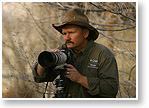
› › quick
shots ‹ ‹
- campfires
& fishing
- Taking
the shot!
- Gillette,
Az
- tip
top, az
- Indian
mesa, az
|